North Carolina Courage can arguably be described as the first true dynasty in the NWSL and have achieved this feat while creating an aggressive and effective attacking style. In this scout report, we will look at a few key cornerstones of Courage’s attacking tactics. Through analysis, we will see their commitment to verticality, intelligent build-up shape, use of attacking fullbacks, diagonal off-the-ball runs and situational direct play allow the Courage to actively attack on multiple fronts. This tactical analysis will hope to shed some light on how Courage are able to create such beautiful attacking play.
Background
North Carolina Courage were founded in 2017 after North Carolina FC Chairman Stephen Malik acquired franchise rights from the Western New York Flash. In their first season, the Courage advanced to the NWSL Championship to lose to Portland Thorns 0-1. Courage then followed up their inaugural 2017 season with two consecutive NWSL championships in 2018 and 2019.
Courage entered the 2020 NWSL Challenge Cup as heavy favourites to win the title. This was reflected in the final group standings with North Carolina perched at the top of the table with four wins and no loses or ties. Also of note, in a tournament marred by lack of preparation time and fixture congestion due to the COVID-19 pandemic, Courage were the only team to finish with a positive goal differential in the group stage (+6). Unfortunately for the Courage, they sputtered in the first knockout stage match and fell to Portland 0-1.
Despite this loss, Courage were debatably the most exciting team to watch in the tournament. This was mostly due to their intense, fluid and unique attacking style.
Verticality
A cornerstone of North Carolina’s attacking play lies in their verticality in attack. We can see this in a few key statistical categories (Note: 2019 season statistics will be cited in addition to 2020 statistics. This is due to 2019 offering a much larger sample size of 24 games).
Firstly, when measuring passes to the final third, North Carolina players held four of the top ten spots. Sam Mewis and Jaelene Hinkle owned the top two spots with 12.68 and 10.53 passes per 90’ respectively. Additionally, the top ten ranked passers to the final third give names such as Lindsey Horan (Thorns), Tori Huster (Spirit) and Christine Nairn (Dash). All of these players are seen as “playmaking” midfielders, while three of Courage’s players in the top ten were defensive players. This reflects that when in possession, all Courage personnel on the pitch look to move the ball forward into attacking spaces as opposed to laterally or backwards.
Courage also held the top two players in deep completions (essentially passes received in the opponent’s box that are not a cross) with Crystal Dunn and Debinha executing 2.83 and 2.66 per 90’ respectively. Once again, North Carolina hold four of the top ten spots in this statistic.
On a statistical level, we see evidence that Courage like to play forward and direct, but their positioning in doing so is what gives them distinction. Courage typically align in a 4-2-2-2, having done so for 71% of their play in the 2020 Challenge Cup.
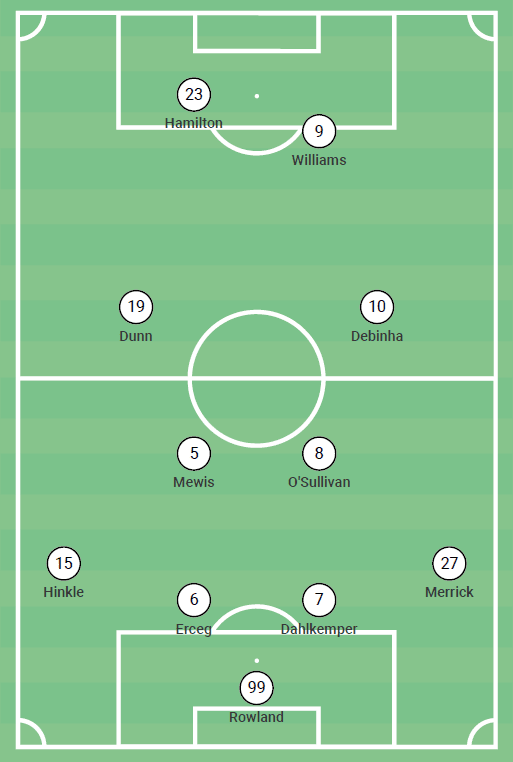
This formation acts as a starting position for the squad, but when in possession, the attacking players become very fluid, often rotating positions. As we can see in the average position chart from Courage’s 2-0 win against Sky Blue, the positioning of the centre-backs and full-backs is not unusual. What is unusual is the average positioning of the midfielders and forwards.
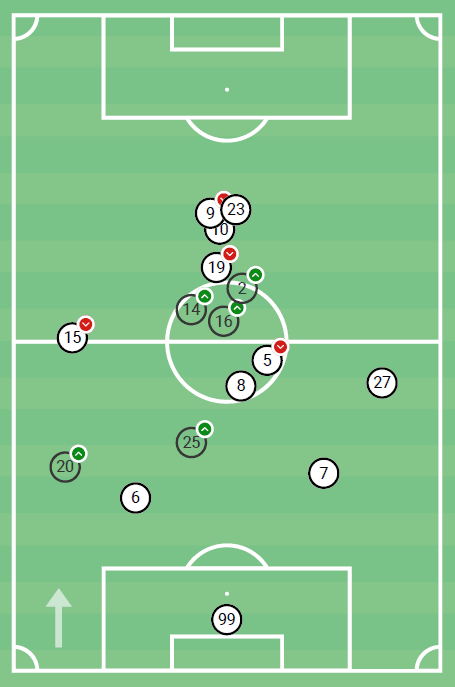
North Carolina attack in such a fluid way, that their attacker’s average positioning end up almost in a single file line down the centre of the pitch. Does that mean that those attackers are actually positioned like this throughout the match? Absolutely not. We see during matches that Courage attackers are given license to switch positions in an effort to disrupt player to player marking systems they may come against.
Build up shape
As we have established above, North Carolina attack primarily with a 4-2-2-2 shape. When building out of the back this results in a team shape that is not uncommon in the footballing world. The centre-backs align in the halfspaces to provide some width without exposing the centre channel to counter-attack. Aligning in the halfspace also aides the centre-back’s ability to open their body to a majority of the pitch when receiving and helps them to be less exposed to blindside pressure when receiving.
Courage are fairly aggressive in their goalkeeping positioning with Katelyn Rowland pushing out of the box to create an additional line of passing options. The two central midfielders Mewis and Denise O’Sullivan position themselves as a double pivot beyond the first line of opponent pressure. In an indication of attacking aggression, the full-backs push much higher up the pitch to create vertical outlets on the flanks.
Mewis and O’Sullivan are also given license to drop below the first line of pressure to aid progression into the middle third of the pitch when warranted. If this does occur, the non-dropping midfielder will slide into a more central position to maintain positional presence in that area of the pitch.
Below we can see an early moment in Courage’s first match of the Challenge Cup. Centre-backs Abby Dahlkemper and Abby Erceg have aligned in the halfspace with the intention to open their body’s diagonal to the pitch. Mewis and O’Sullivan have dropped into space behind the first line of opponent pressure.
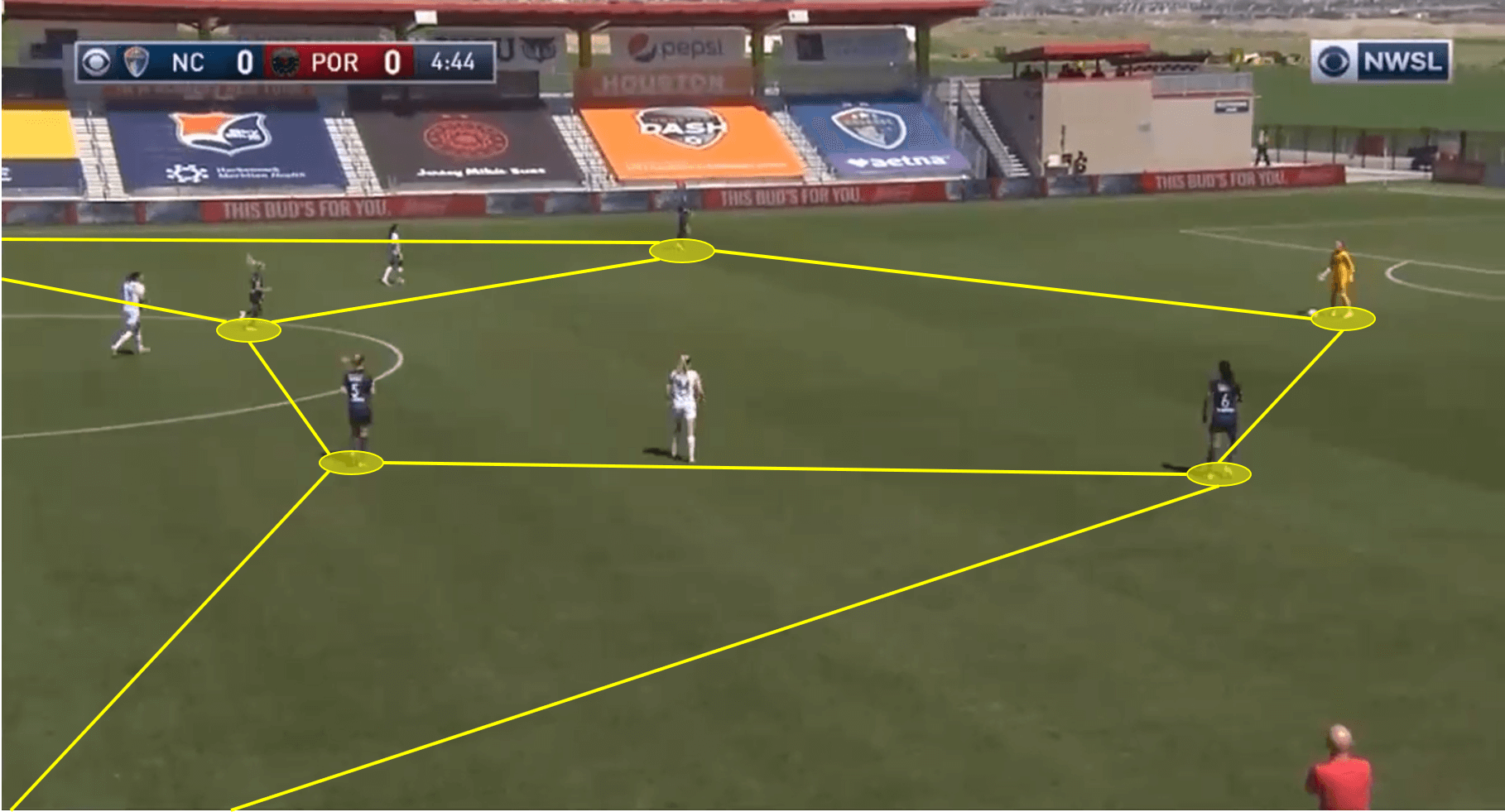
Rowland is in possession of the ball outside of the box, allowing the rest of the team to push higher up the pitch. We also see that the full-backs are so highly positioned that they cannot be seen in the image. This leads us to infer that in this moment, Courage are occupying attacking space in both flanks, both halfspaces and the central channel while the goalkeeper is in possession.
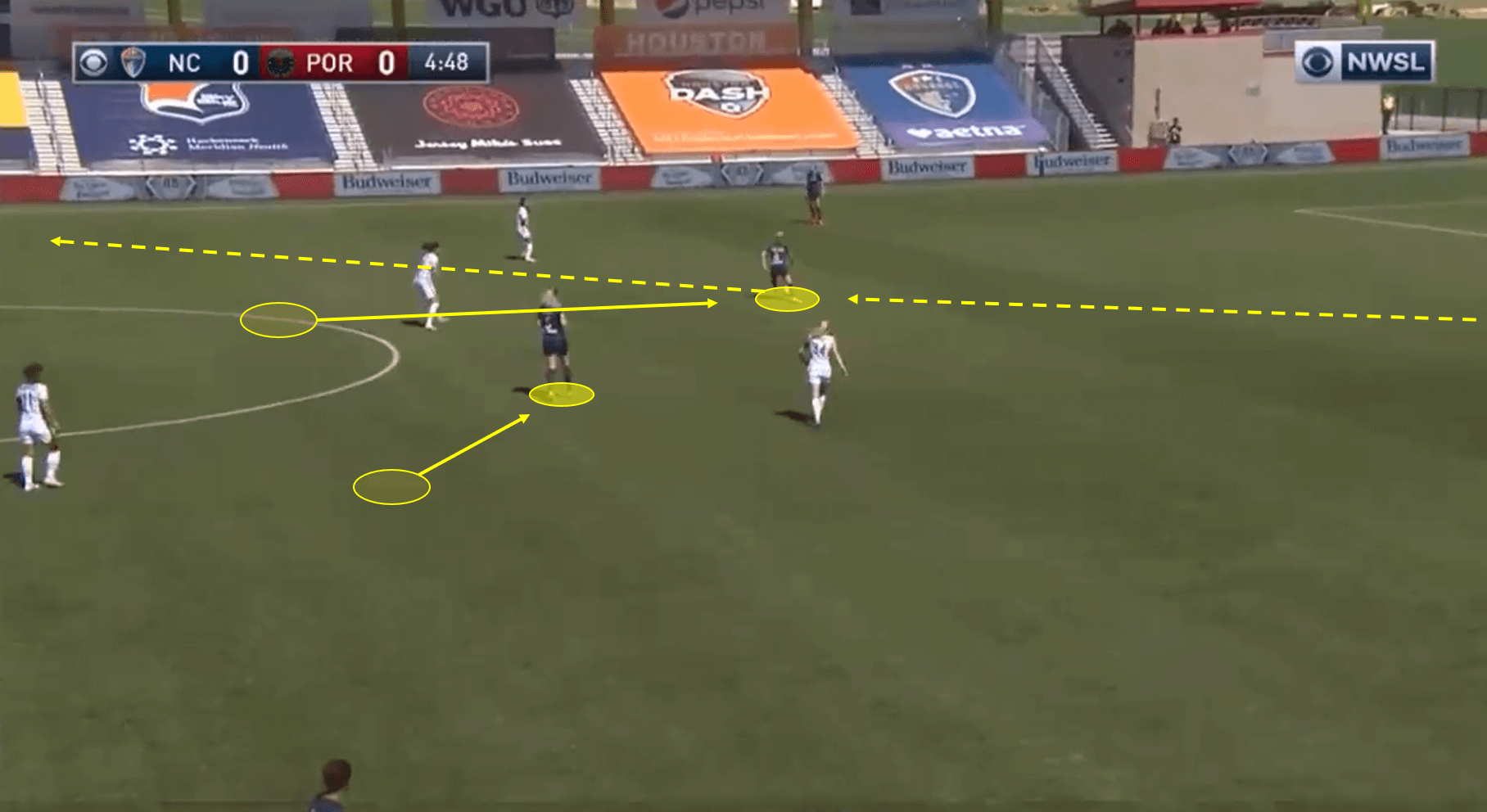
In this instant, both centre-backs are quickly pressured by Thorns players when they receive the ball. Recognising this, O’Sullivan drops lower in the central channel to receive in front of the first line of pressure. The central Thorns player chooses not to close her down, knowing that by doing so she would open a vast amount of space for Mewis to receive in. As O’Sullivan drops, Mewis slides into a more central position to maintain Courage’s central presence beyond the first line of pressure.
Attacking full-backs
North Carolina are unsurprisingly aggressive in their use of full-backs as well. Manager Paul Riley primarily utilises Addisyn Merrick and Hinkle in the full-back position and encourages them to push high up the pitch in attack. This is done for multiple reasons.
Firstly, both are capable of winning attacking 1 vs 1 situations (Hinkle engaged in 47 offensive duels in five games Challenge Cup matches, third-most on the team). This allows both full-backs to either provide width on the flank or tuck into the halfspace when entering the attacking third. When entering the attacking third with the ball, the full-backs can create a few primary situations. A) They can engage in a 1 vs 1 to break the midfield line of pressure and create a new platform for attack. B) They can engage in a 1 vs 1 to break through the opponent defending line to create a chance on goal. C) They can cut inwards or outward to create a cross into the box. D) They can use their penetration to draw in pressure to create attacking space for teammates.
Below we will see examples of Hinkle executing all four of these situations. In their match against Sky Blue, Courage are pushing forward as a unit and releasing the ball into opening spaces as they go. The ball eventually finds Debinha, who recognizes that Hinkle has a large amount of attacking area in the left halfspace. Debinha releases the ball to Hinkle. As the ball is released, Kristen Hamilton makes a central diagonal run to draw the attention of the Sky Blue centre-backs.

This leaves Hinkle in a 1 vs 1 situation against the opponent’s right-back. In this moment Hinkle has two main options. She can move the ball onto her left foot, accelerate past the defender and create a chance on goal. Or she can cut inwards to create an in-swinging cross with her right foot. We can see in the image below that on the far side of the box, two Courage attackers have positioned themselves for a potential 2 vs 1 situation on the far post. Hinkle takes the first option but loses possession as she attempts to bypass the defender.
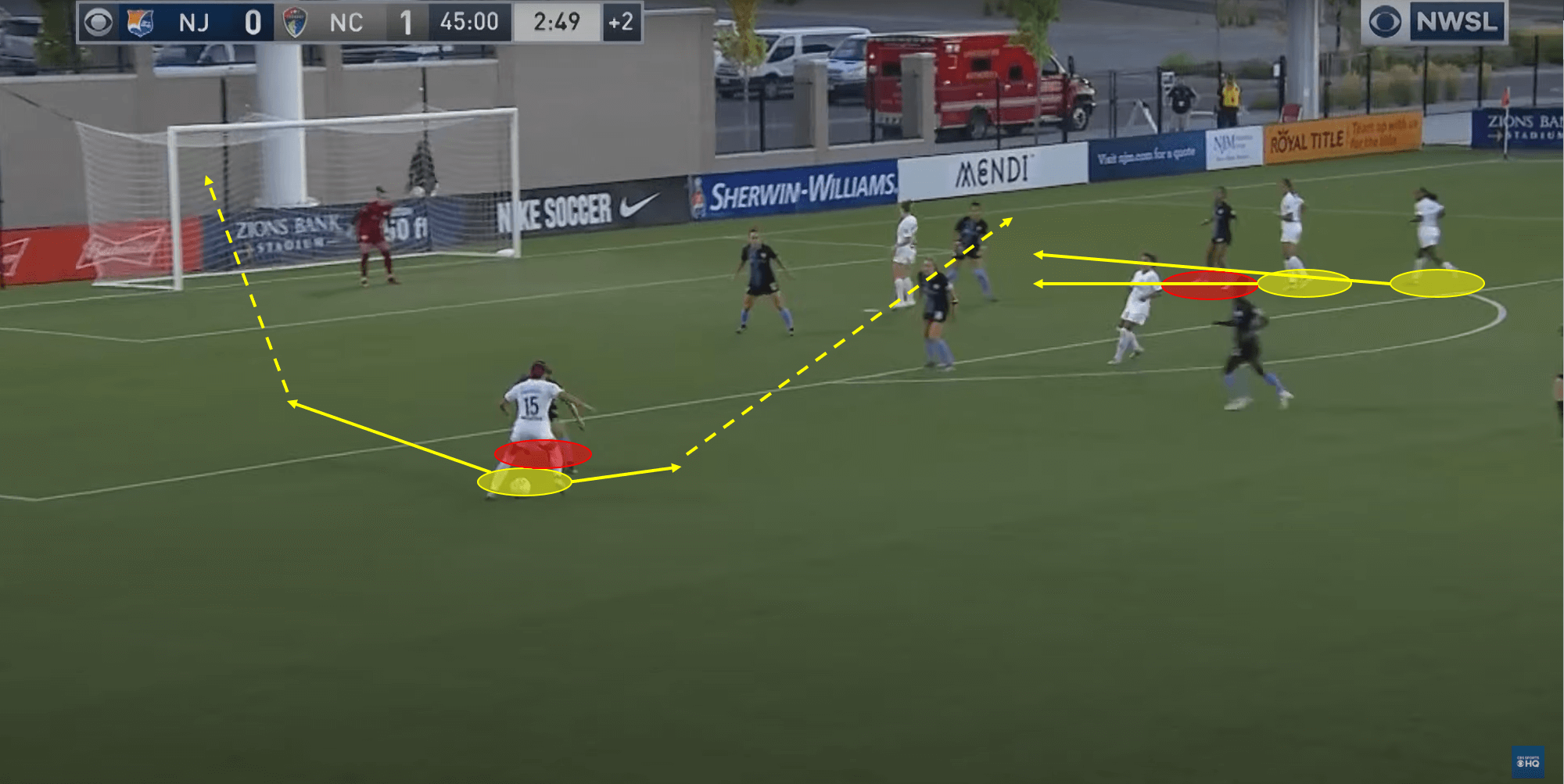
Hinkle can also be effective from deeper areas on the pitch. In their first match against Portland, Hinkle has received the ball in the halfspace in front of the Thorns midfield line. Hinkle chooses to engage in a 1v1 (playing the ball through the opponent’s legs) to advance Courage’s possession into the final third.
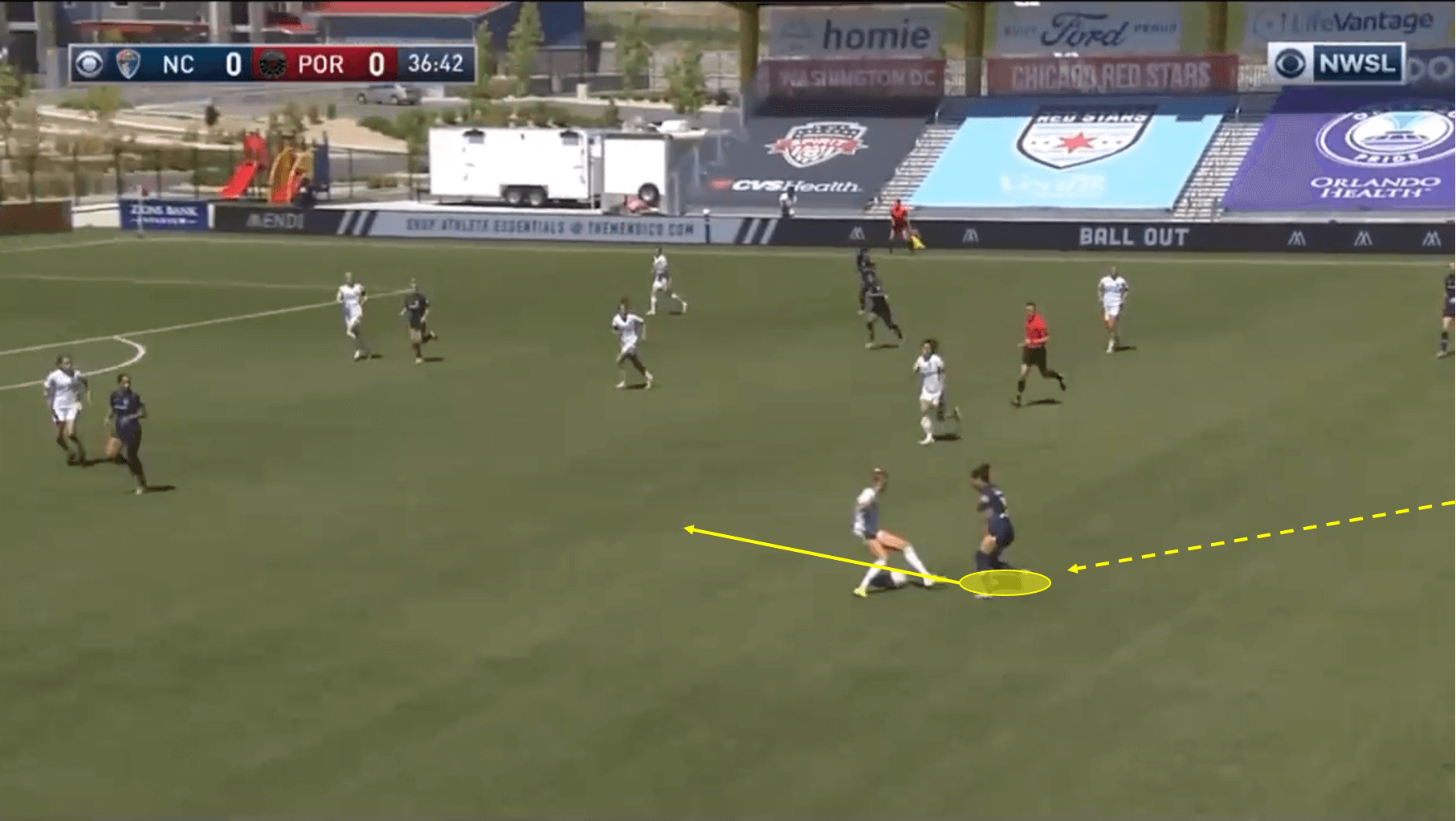
Hinkle drives directly at the Thorns defensive block and in doing so, draws in pressure from three nearby players. With this unexpected penetrating run, Hinkle has opened up a vast amount of space on the left flank for teammate Lynn Williams. Waiting until the last possible moment, Hinkle releases the ball to Williams who then attempts a low cross into the box.
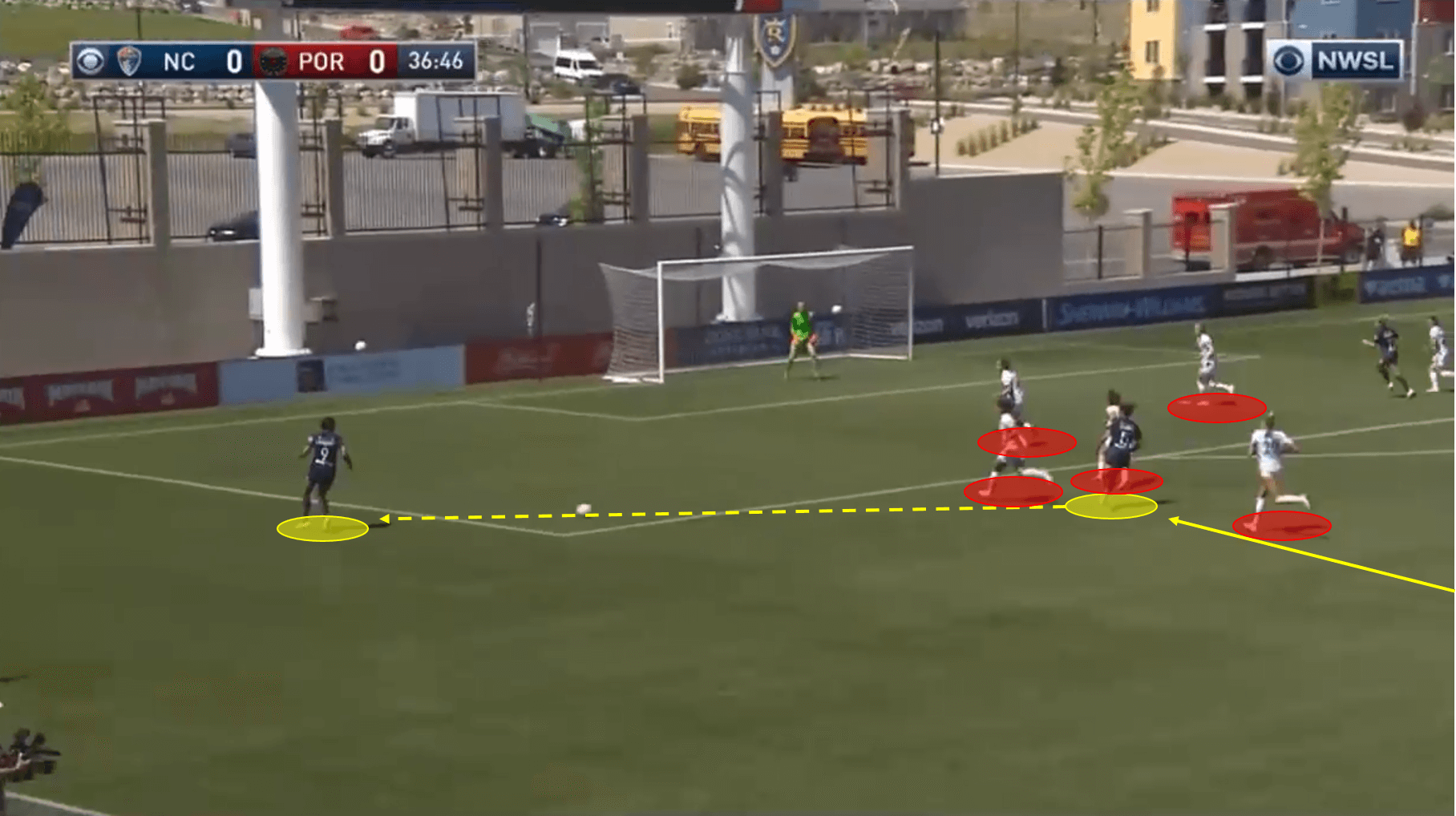
Diagonal runs on the flanks
An important tool in the arsenal of Courage’ attacking tactics is the use of diagonal runs when entering the attacking third of the pitch. As we saw from the team’s average position graph, the attacking players tend to remain very narrow throughout the match. This helps in Courage’s transition phase when the team aims to counter-press to win the ball, but also serves an important role when attacking.
Courage players will often remain narrow, subsequently allowing the opposition to remain narrow and compact as well. Entering the attacking third, Courage players will then execute a diagonal run into an open flank. This typically leads to the opponent outside-back to track the run and be dragged out of their backline. As this occurs, a deeper attacker, often Dunn or Debinha will quickly penetrate the created space to receive in a dangerous position.
This specifically timed attacking run, allows North Carolina to time when attacking spaces are created. This is as opposed to having a winger stay high and wide on the touchline, giving the direct opponent the luxury of openly perceiving the space that North Carolina is attempting to create. By remaining narrow until the exact attacking moment, Courage are able to quickly and dangerously create attacking space while the opponent is left to react to the movements.
This can also allow the Courage attackers to create fake diagonal runs to mislead the outside-back and then quickly move back into the space the attacker has just created.
In their first match against Thorns we can see a moment in which Merrick has gained possession on the right flank and is entering the attacking third. Dunn, who has maintained a central position up until this moment, suddenly makes a darting diagonal run to the right flank. Dunn, who is penetrating towards a completely open flank is able to receive in space unopposed.
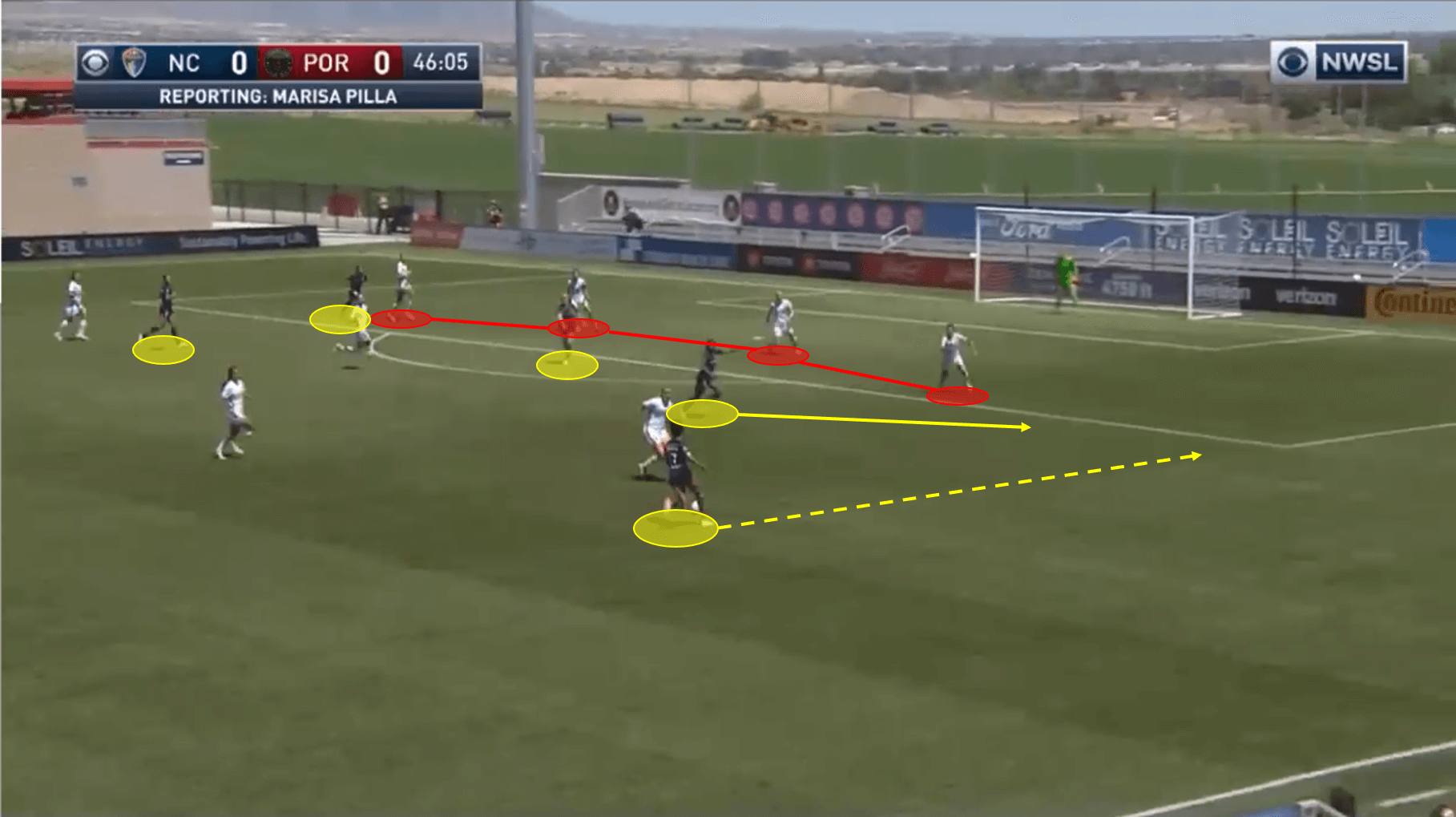
Dunn’s attacking run drags the Thorns left-back with her, creating a gap between the Thorns left-back and left centre-back. Merrick immediately breaches into the newly created space, sprinting directly at the Thorns goal. Dunn receives and controls the ball, then quickly releases a low cross into the path of the streaking Merrick. The cross is unsuccessful, but we can see that Courage were able to create attacking space and almost create a goal within just a few seconds.
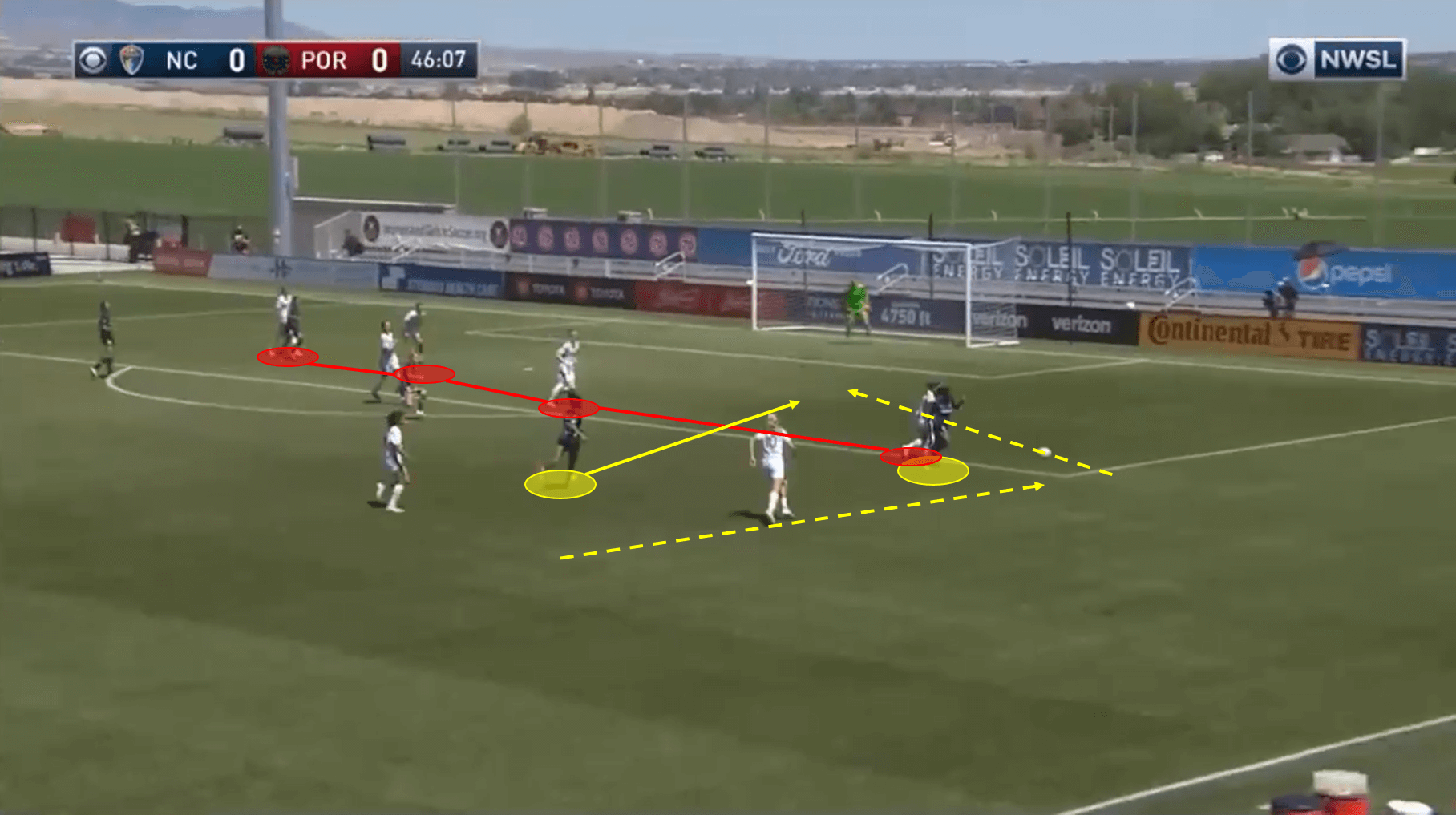
The danger of Courage’s diagonal attacking runs often leads defenders to over-commit to tracking the run. We can see Courage using this to their advantage in the images below. In the match against Sky Blue, Merrick has once again received the ball on the right flank while her attacking teammates remain centrally positioned. As the ball travels to Merrick, Hamilton begins her diagonal run into the right flank. The Sky Blue left-back closely tracks her run.
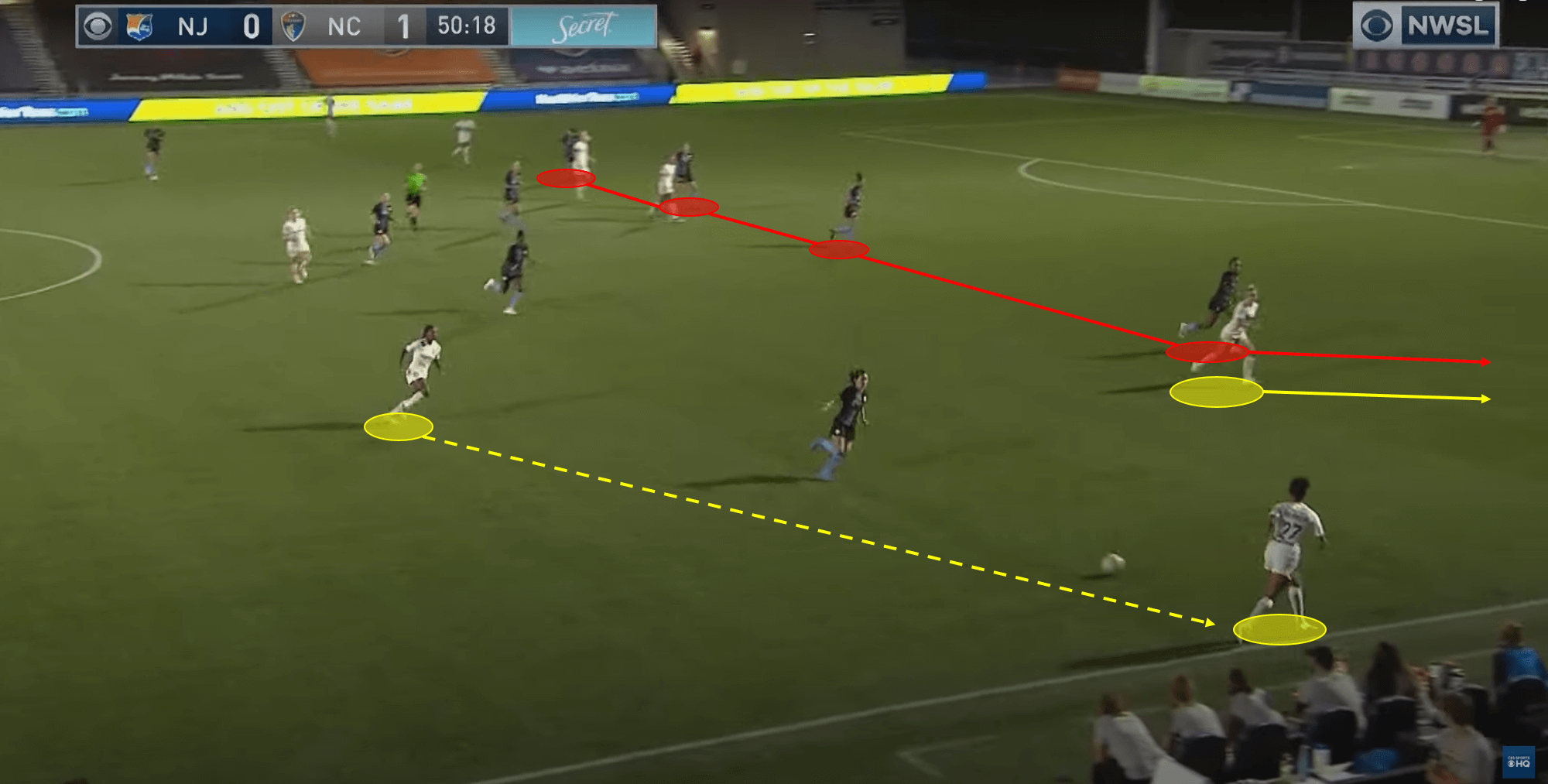
Hamilton, instead of moving into space that Merrick is pushing into, decides to cut back inwards and moves towards the New Jersey goal. Despite this change in movement, the Sky Blue left-back continues her initial tracking run and moves into a 2 vs 1 situation against Merrick in the right flank. Merrick perceives that Hamilton is now completely unopposed in the right halfspace, with no one available to stop Hamilton from penetrating towards the goal.
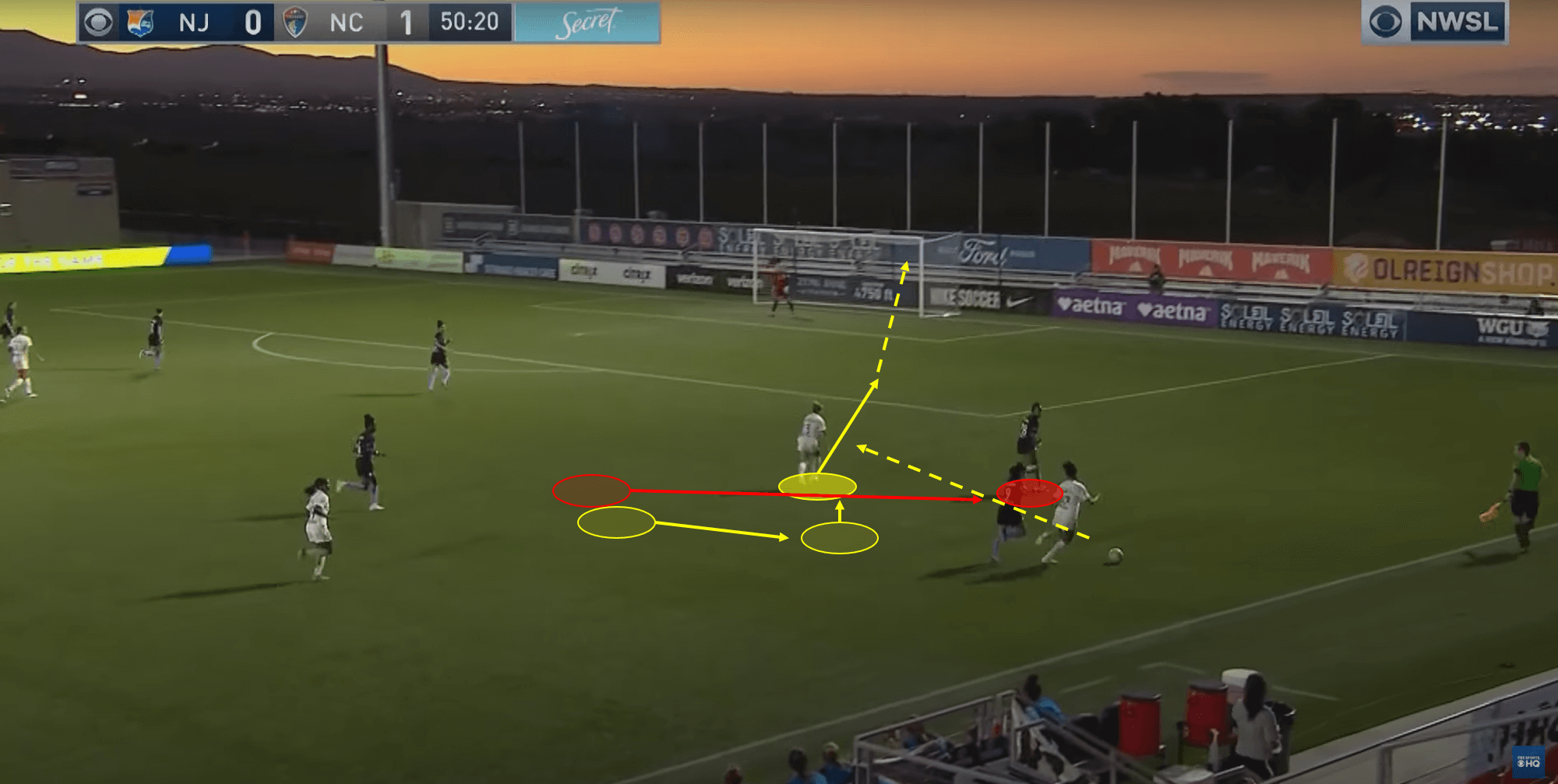
Merrick releases the ball between her two pressuring defenders to Hamilton, who is able to receive the ball and create a chance on New Jersey’s goal.
Playing Direct
Much like we have seen with Klopp’s Liverpool, Courage are not afraid to attack space behind when opponents aim to restrict space between the lines. We can see evidence of this from the 2019 season when Courage had 65.74 passes to the final third per 90’, ranked first in the league. They also had 92.06 progressive passes per 90’ which was not only first in the league, but also ten more per 90’ than the second-place team (Red Stars). This is done through two primary outlets, the individual attacking abilities of Williams and the vision and passing ability of Mewis.
Mewis acts as a deep playmaker who has the awareness to find lethal gaps of space on the pitch. This is reflected in Mewis’ 43 passes to the final third and a massive 61 progressive passes in Courage’s five matches played in the Challenge Cup. Progressive passes are considered a pass that moves the ball “considerably forward”.
Williams is often the receiver of direct balls from Mewis. This is revealed in Williams’ team-leading 75 offensive duels completed in North Carolina’s five Challenge Cup matches. Williams is able to create chances through her spatial perception and timing of runs into space behind the opponent’s backline. Because of Williams’ natural speed, she is able to sit deeper in front of the opponent backline, waiting for Mewis (or another Courage player) to receive the ball and turn their vision upfield. In that moment, Williams will begin a sprint towards the backline. There are many times in which the ball is played into space behind the opponent backline, Williams is a few steps behind the nearby defender. But as the ball is travelling, she is able to gain ground and as the duelling players arrive on the ball, Williams is in a better position to gain possession. Once the ball arrives, Williams is able to use quick lateral movements to unbalance and mislead the defender and eventually create chances on goal.
Below, we see an example of this tactic against Sky Blue. Mewis has received the ball in the left halfspace in the Courage defensive third of the pitch. Three nearby Sky Blue players are available to pressure Mewis, but none do so. This gives Mewis ample time to turn her vision up the pitch and see that Williams is lying in wait in front of the New Jersey defensive line.
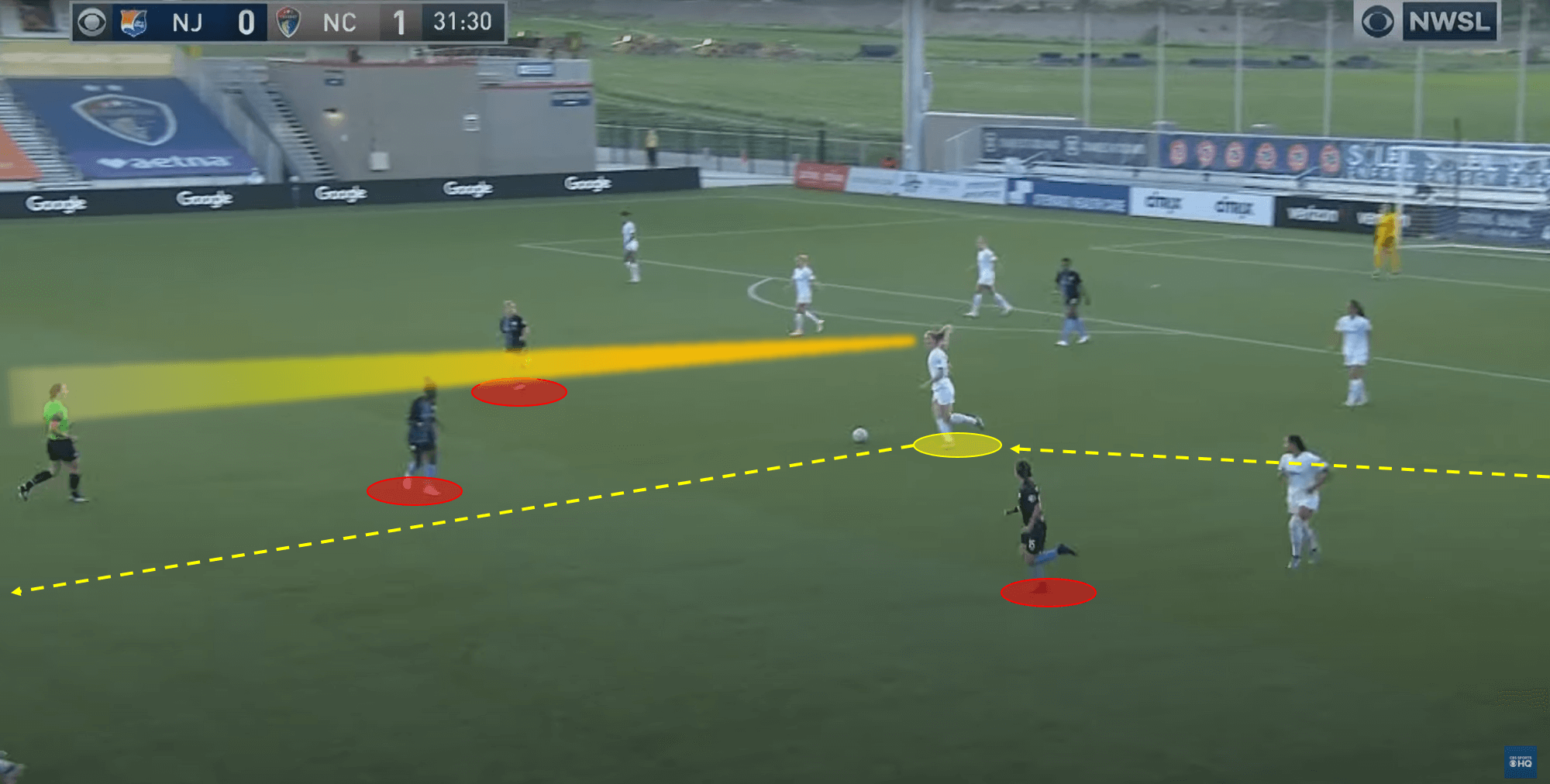
Mewis releases an aerial ball into the path of a now sprinting Williams. It must be noted that when the ball is first released, Williams is behind the defender by a few steps. As the ball arrives, Williams has passed the defender who has now peeled off to defend the goal. In a matter of seconds, Williams is ready to receive the ball in the attacking third and set up for a frontal 1 vs 1.
Williams receives the ball in stride, takes a touch to control, fakes towards the goal line with her shoulders and then cuts inside with the outside of her right foot. As we can see in the image below, Williams’ shoulder fake has completely unbalanced the defender and given her time and space to take a shot on goal.
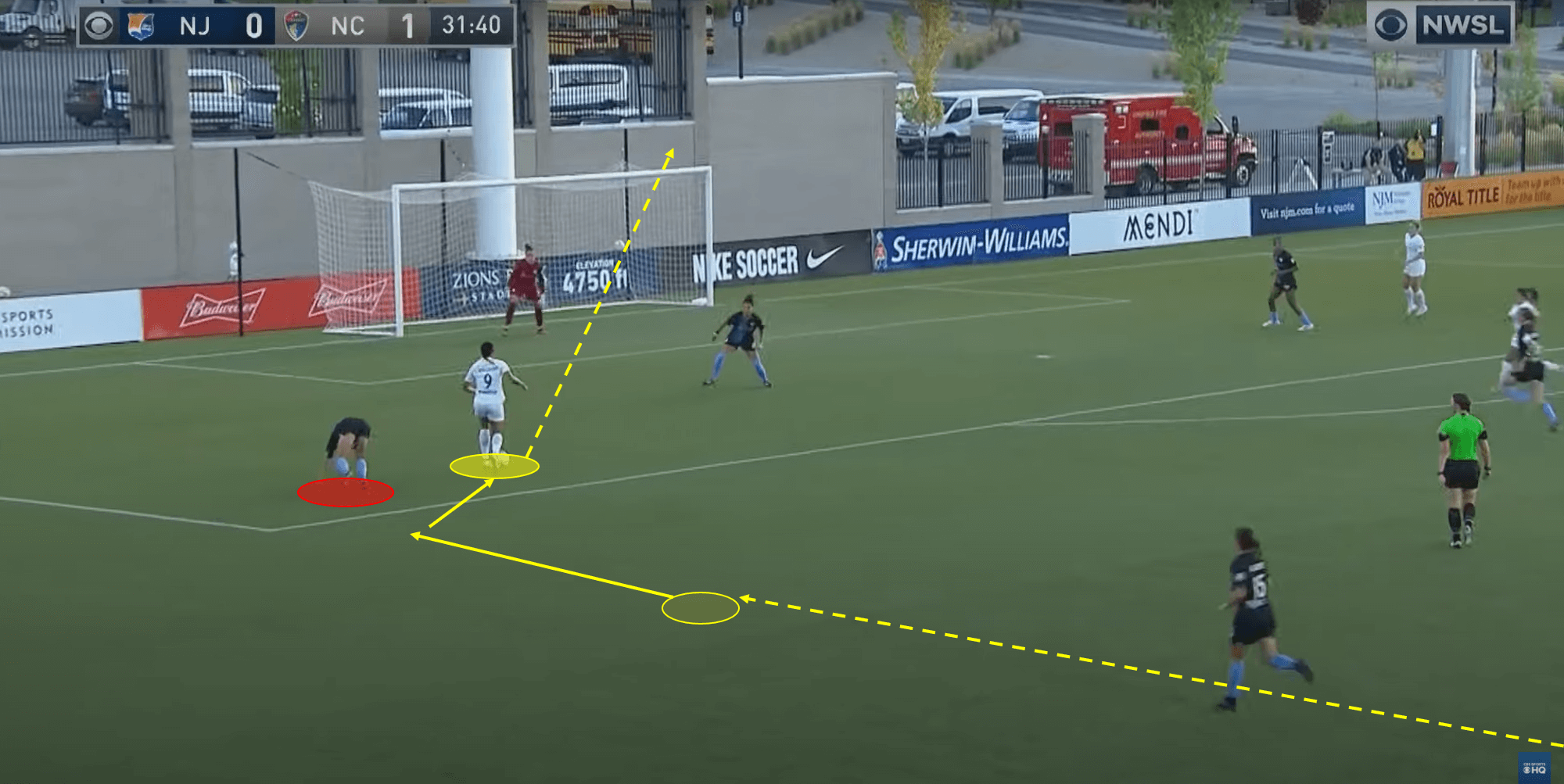
Conclusion
Despite their elimination in the quarterfinals of the 2020 NWSL Challenge Cup, North Carolina created some of the most exciting and aesthetically appealing attacking moments of the tournament. Enough so that Manchester City are reported to yearn for Mewis as a central midfielder for their upcoming FAWSL campaign. We are sure to see more of the same effective attacking flair from the Courage in the 2021 season.





Comments